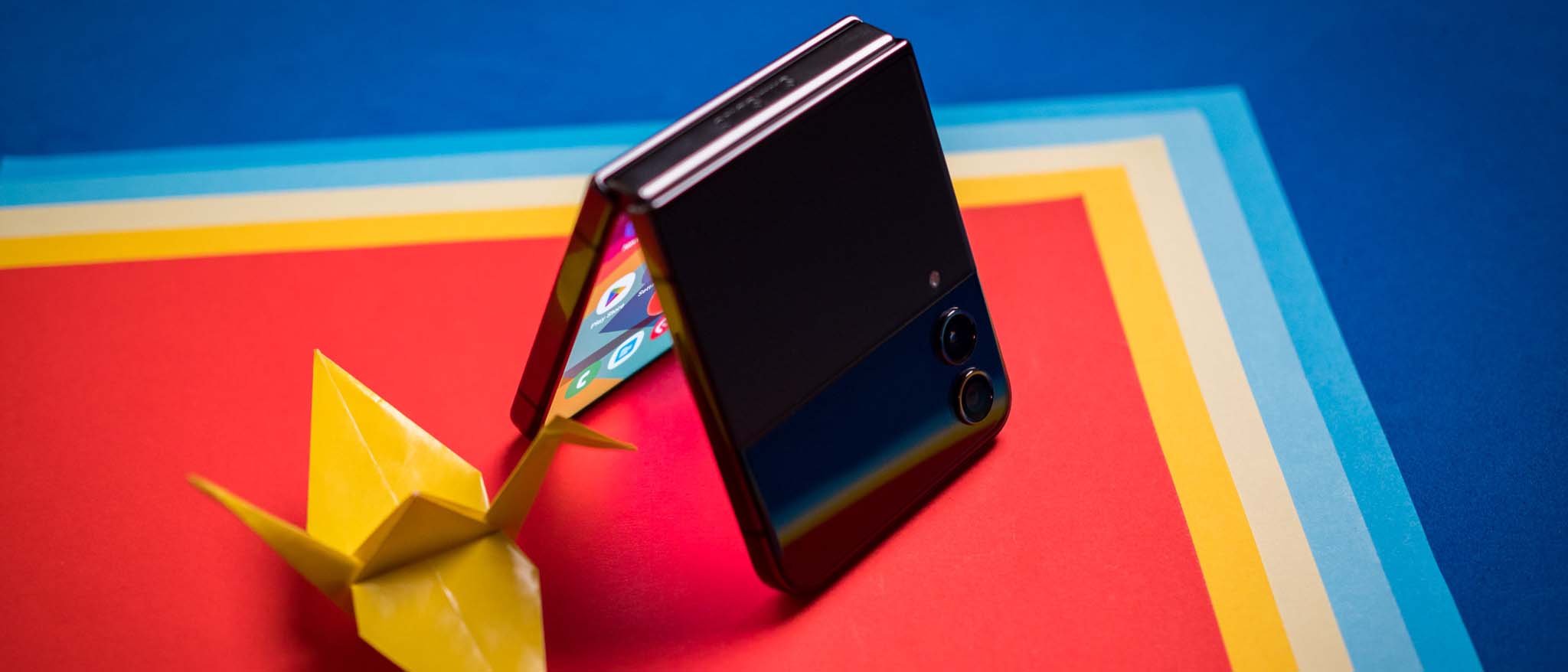Android Central Verdict
The Galaxy Z Flip 4 is the embodiment of Samsung's foldable efforts over the last three years. The design is elegant but durable at the same time, the hinge is built to last, and the 120Hz AMOLED screen is wonderful in daily use. The cameras are on the same level as the S22+, the outer cover screen acts as a viewfinder, and battery lasts all day and has faster charging tech. More than anything else, this is a fun foldable to use, and if you want a phone that stands out, the Z Flip 4 is the obvious choice.
Pros
- +
Foldable design is inherently pocketable
- +
120Hz AMOLED screen is wonderful
- +
Just as durable as regular phones
- +
Outstanding internal hardware
- +
Excellent cameras
- +
All-day battery life with faster charging
- +
IPX8 water resistance
- +
Four Android OS updates
Cons
- -
Throttles under heavy load
- -
Visible crease
- -
Screen isn't polarized
Why you can trust Android Central
You're not alone in thinking that phones are starting to look the same. I used more than 40 phones this year, and other than choice of materials — glass, polycarbonate, ceramic, or metal — there isn't much in the way of differentiation, with most phone designs starting to blend together.
Sure, there are a few phones with bold designs like the Xiaomi 12S Ultra, Find X5 Pro, Zenfone 9, and the LED extravaganza that is the Nothing phone (1), but on the whole, there hasn't been much in the way of change. Thankfully, that's where Samsung comes in. The Z Flip 4 injects excitement into a staid category, delivering a durable chassis with a hinge design that's built to last, noteworthy upgrades from last year, and flagship-tier cameras.
More than anything else, using the Z Flip 4 is fun; the action of physically opening or closing the phone immediately evokes nostalgia. Samsung took a bold idea and tweaked away at it for the last three years, and the result is a foldable design that feels just as durable and rugged as a regular flagship. And while the Galaxy Z Fold 4 has an exorbitant price tag that limits it to enthusiasts, the Z Flip 4 costs the same as a regular Galaxy S22+, making it that much more accessible to a wider audience.
Combine that with all the upgrades on offer here, and the Z Flip 4 is one of my favorite phones of 2022. I went through a lot of phones this year, but nothing came close to delivering the same level of excitement I got while using the Z Flip 4.
About this review
I'm writing this review after using the Z Flip 4 for over two weeks in Hyderabad, India. The phone didn't pick up any software updates in the testing window, and it was running One UI 4.1.1 with the May 2022 security update out of the box. Samsung India furnished the unit to Android Central for review.
Samsung Galaxy Z Flip 4: Pricing and launch
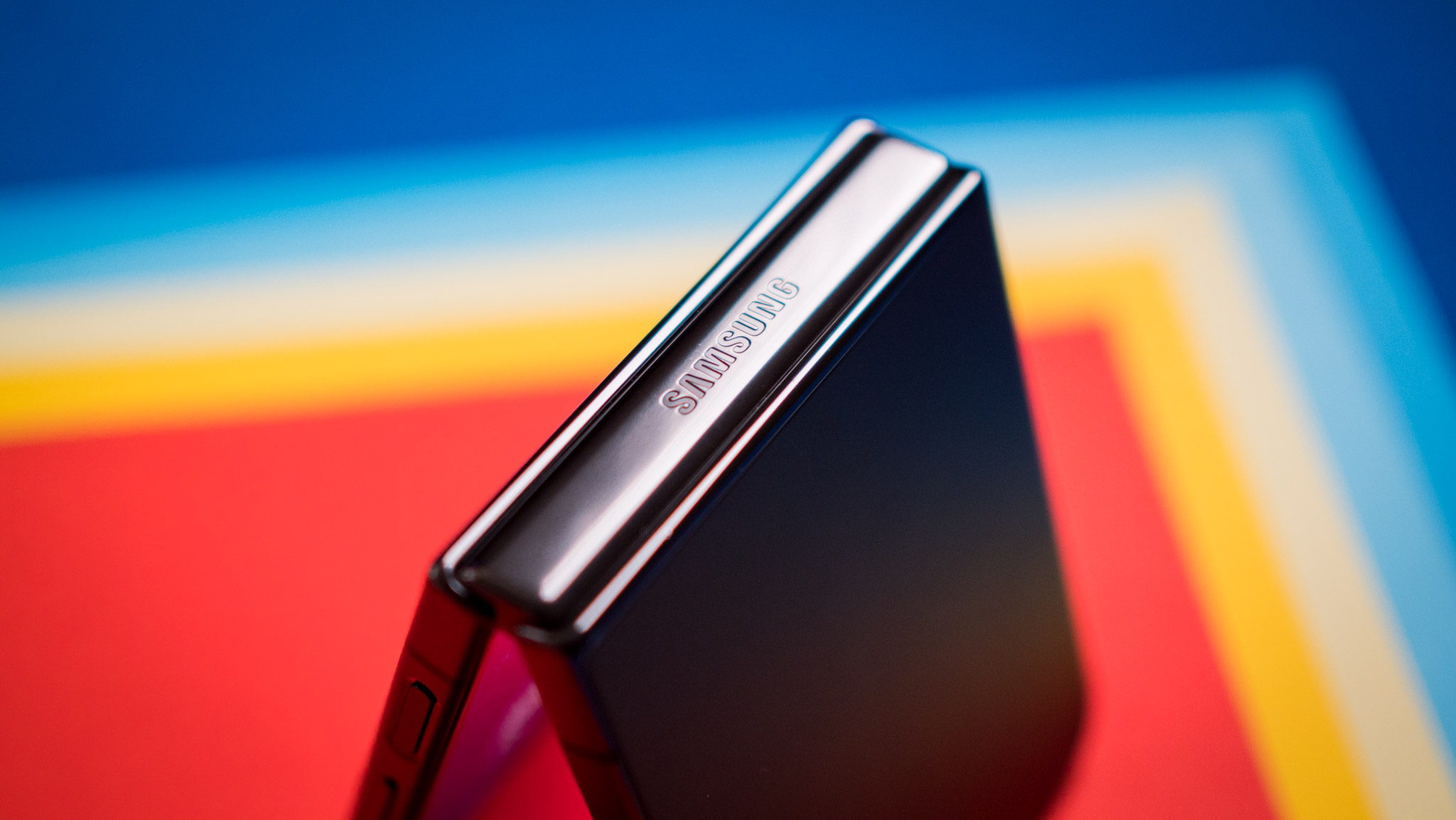
Samsung unveiled the Z Flip 4 on August 10, 2022, with the device going up for pre-order the same day. Sales kicked off August 26, and the Z Flip 4 is available at all four U.S. carriers as well as Amazon, Samsung, and other retailers. Outside North America, the foldable is available at all major retailers alongside Samsung's official storefront.
The Z Flip 4 retails for $999 in the U.S. for the unlocked version, and you'll find the usual plethora of carrier deals and incentives if you're upgrading your phone — we've rounded up the best Galaxy Z Flip 4 deals here. The phone is available with 8GB of RAM as standard and starts off at 128GB of storage for the base variant, going up to 512GB.
Get the latest news from Android Central, your trusted companion in the world of Android
It's sold in Bora Purple, Graphite, Pink Gold, Blue, Yellow, and White color variants, but not all colors and storage variants are available in all regions. You'll also find a Z Flip 4 Bespoke Edition that lets you customize the colors of the device, but that option is limited to the 8GB/256GB variant. Here's what it costs around the world:
- Galaxy Z Flip 4 (8GB/128GB): $999 / £999 / €1,099 / ₹89,999
- Galaxy Z Flip 4 (8GB/256GB): $1,059 /£1,059 / €1,159 / ₹94,999
- Galaxy Z Flip 4 (8GB/512GB): $1,179 / £1,199 / €1,279
- Galaxy Z Flip 4 Bespoke Edition (8GB/256GB): $1,139 /£1,099 / €1,199 / ₹97,999
Samsung Galaxy Z Flip 4: Design

Samsung didn't change the design too much from last year, and as a result the Z Flip 4 looks largely identical to the Z Flip 3. The biggest design change includes flatter sides, with the Z Flip 4 resembling its Galaxy S22 siblings in this regard. I don't usually like phones with boxy sides, but it absolutely makes a difference here — it makes the foldable just that little bit easier to hold.
The Z Flip 4 uses the same design foundation, but it is easier to hold and use, and you get exciting new colors.
The design aesthetic continues to be just as striking as last year, with the two-tone finish around the cameras and cover screen contrasting really well with the matte texture at the back. The Z Flip 4 has a glass back that's split into two panes, with both covered by Gorilla Glass Victus+. Samsung went with a matte texture for the glass this time around, and it feels delightful. Samsung is once again offering the Z Flip 4 in striking colors — the Bora Purple version looks stunning — and like last year, you get the ability to go further and customize the colorways if you opt for the Bespoke Edition.
The glass panes at the back are joined by an aluminum mid-frame that has a glossy finish, and I'm not a big fan of the texture. It would have made more sense to go with a matte finish at the sides as well, but that said, the glossy finish doesn't affect usability too much. The chassis itself has been hardened, with Samsung making changes to the aluminum alloy structure to make it a little more durable.
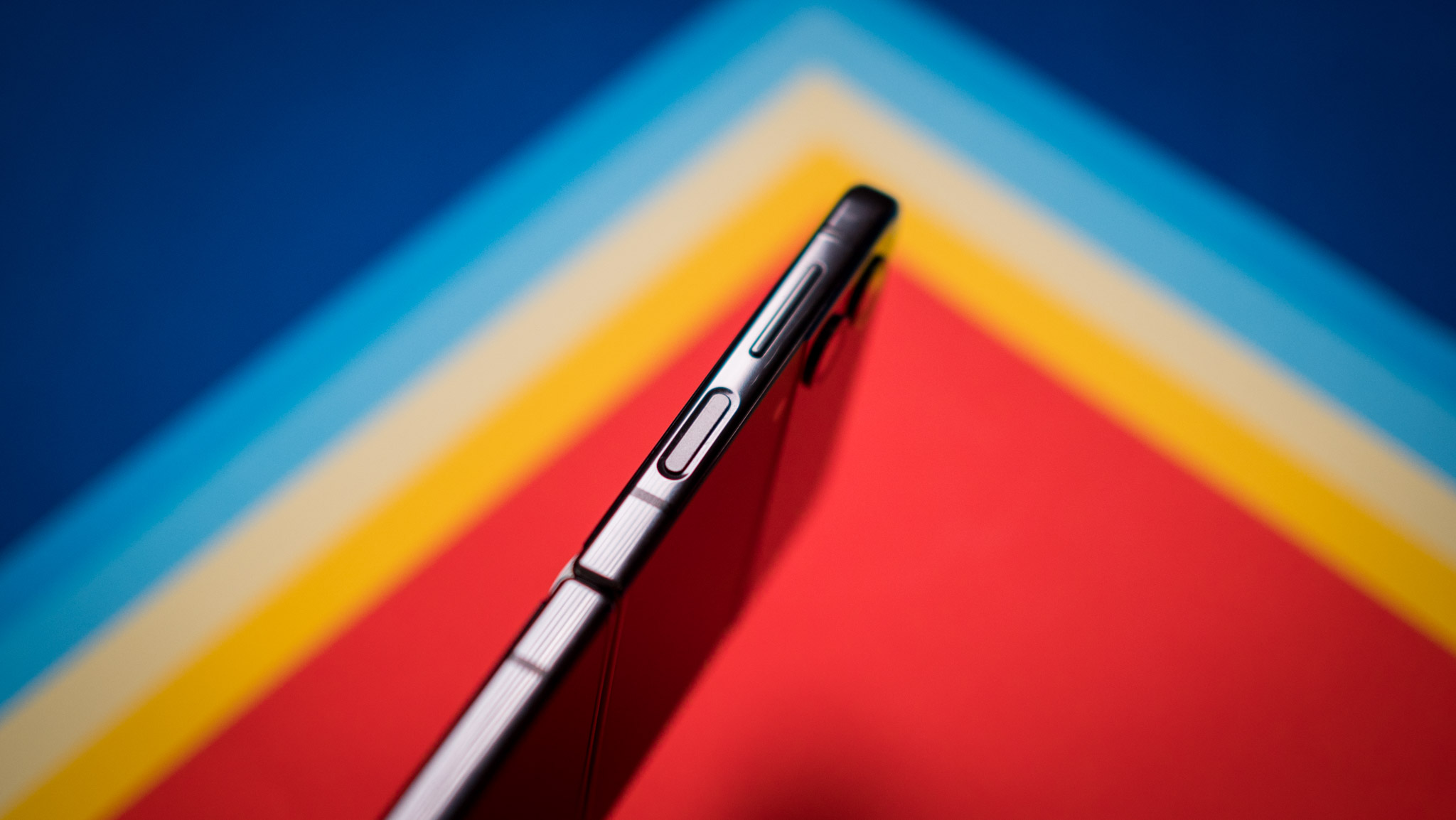
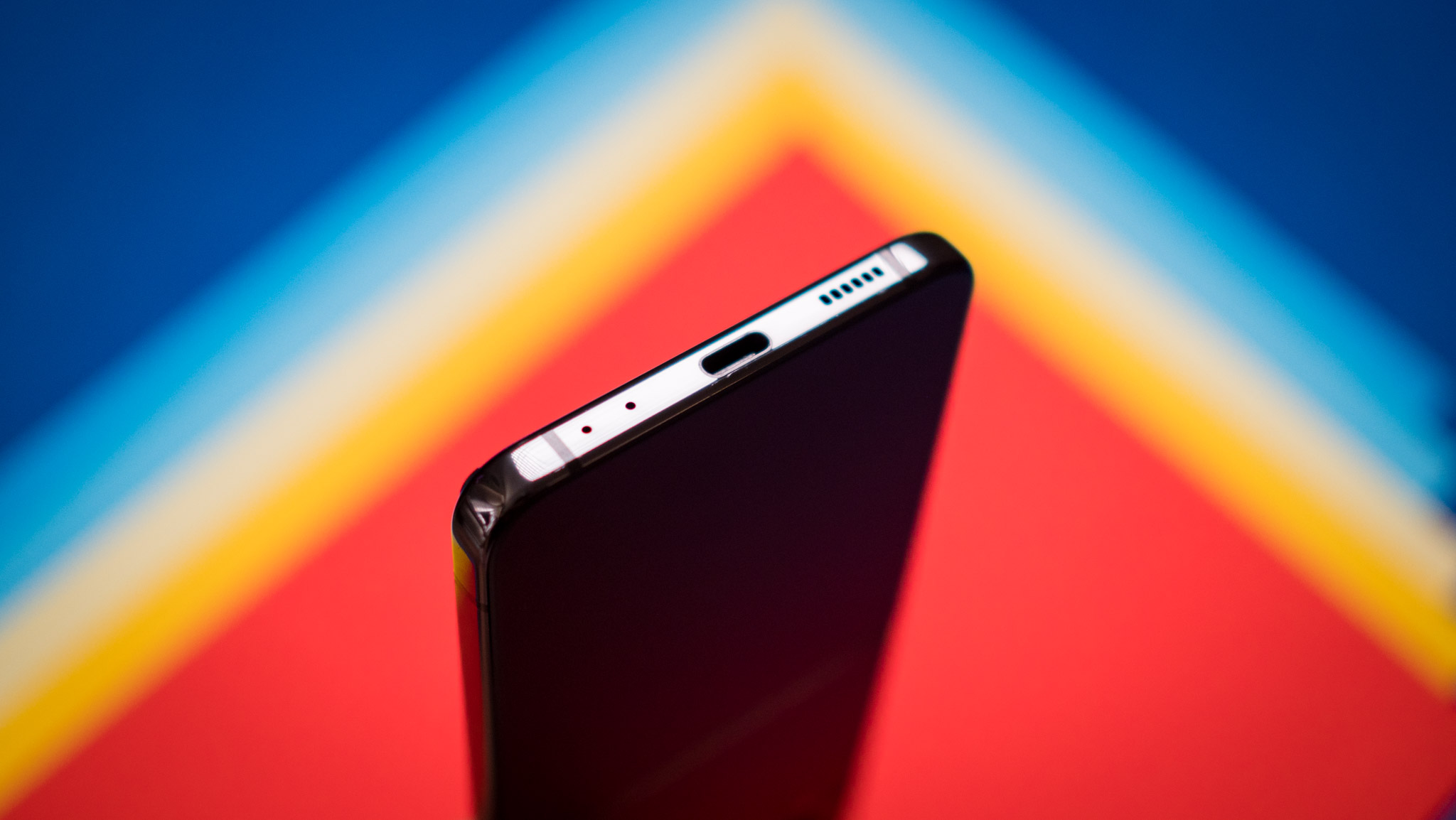
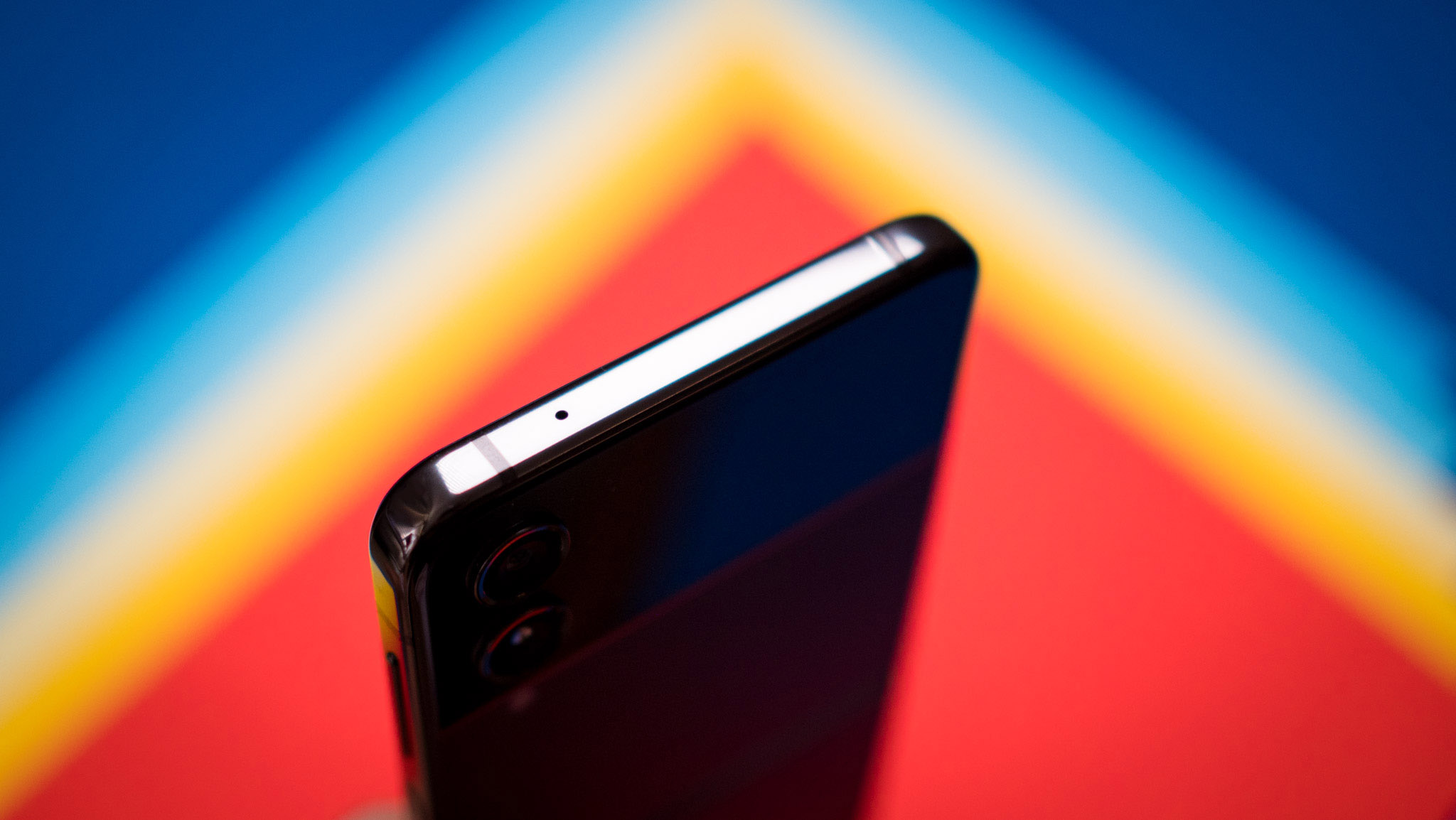
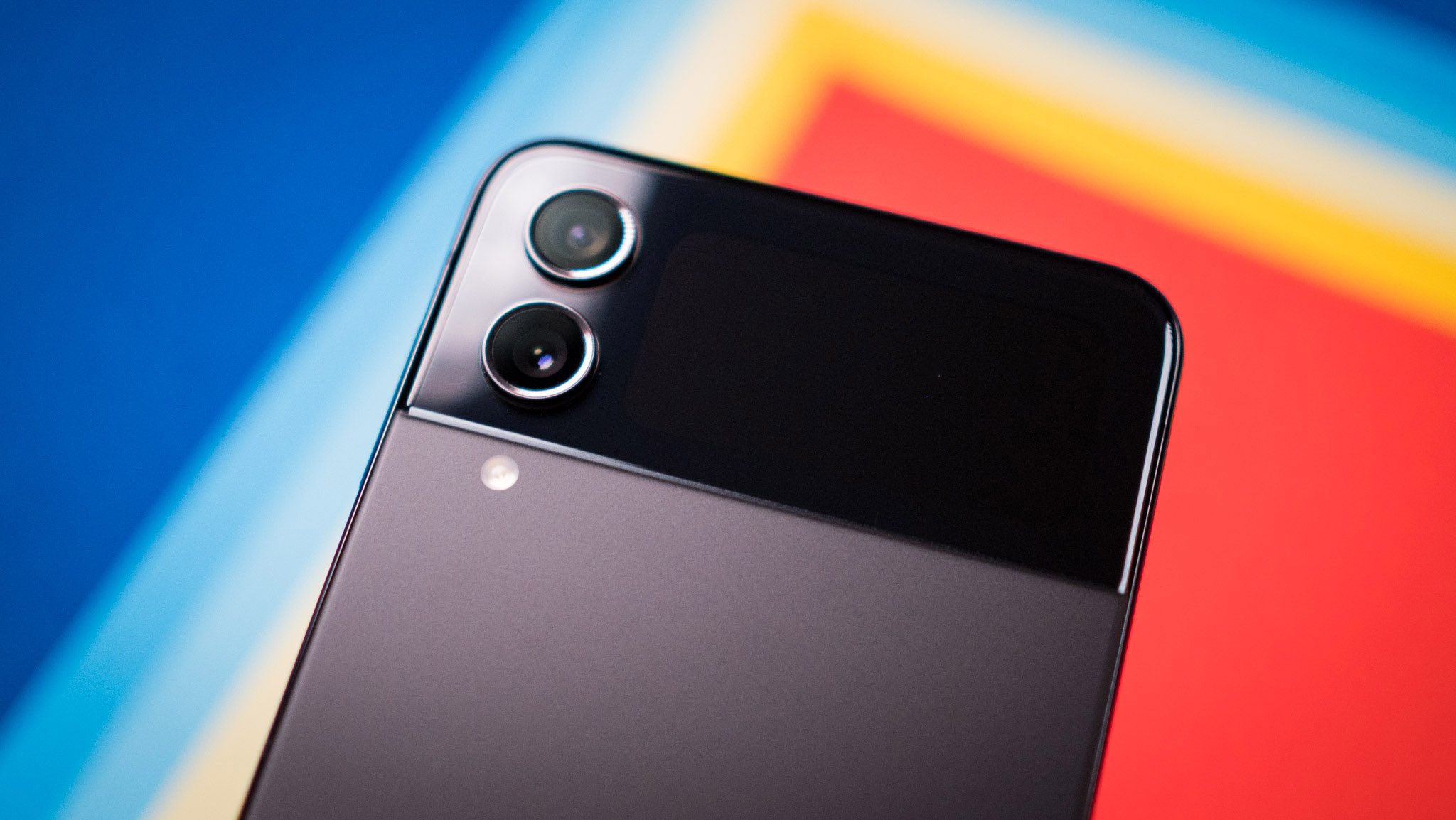
That is evident in daily use; I didn't make any considerations to the fact that the Z Flip 4 is a foldable, and used it just as I would any other phone. After two weeks of trying to pry the lid one-handed, the occasional tumble, and jangling about in my pocket, the Z Flip 4 has shown no signs of wear.
The hinge now lays fully flat, and the Z Flip 4 feels just as durable and robust as a traditional flagship.
Samsung did a magnificent job making the Z Flip 4 feel just as robust as any other flagship, and a large part of that is down to the hinge. The hinge has a smooth motion, feels robust, and is thinner than last year. Samsung says it will last 200,000 cycles before wearing down, and I have no cause to doubt that — it feels reassuringly durable in daily use. Furthermore, the hinge now folds fully flat, just like the Z Fold 4; this wasn't the case last year.
You'll find antenna bands on either side, and the power button and volume rocker on the right. The phone has a side-mounted fingerprint sensor that's baked into the power button, and it is fast and reliable. The SIM card tray is on the left and houses two SIM cards (outside North America), and the USB-C port is at the bottom. And the camera lenses at the back don't protrude too much, so there isn't any wobble when using the foldable on a flat surface.

Like last year, the Z Flip 4 is IPX8 water resistant, and I tested this particular claim thoroughly. The foldable worked just fine after dunking in water for about 10 minutes, and while the hinge leaked water for a few minutes even after drying out the phone, it didn't affect usability in any way.
On that note, the Z Flip 4 is 4g heavier than last year's foldable, but coming in at 187g, it doesn't feel cumbersome at all. Due to its height — it is 2mm taller than the S22 Ultra — it feels a bit top-heavy and somewhat unwieldy when using one-handed, and it could have been a bit wider to offset the height. That said, it feels good to hold and use.

What I realized using the Z Flip 4 was that it doesn't feel like a tech demo; this is every bit a mainstream device as the S22+, Pixel 6 Pro, or the Find X5 Pro. The foldable design is inherently enjoyable to use, and the act of physically opening the phone to interact with the screen, and closing it once you're done, is joyous. That tactility has been missing in recent years, and I'm glad Samsung found a way to reintroduce that.
Having used flip phones back in the early 2000s, the Z Flip 4 immediately took me back to that simpler time, and more than anything else, it's that nostalgia that made me like this phone so much. Oh, and this thing will turn heads in public; a few people even mistook the foldable for a regular flip phone and did a double take when they saw the screen.
Samsung Galaxy Z Flip 4: Screen

The Z Flip 4 uses the same 6.7-inch AMOLED panel as last year, and the 1.9-inch cover screen is also identical. The cover screen has a layer of Gorilla Glass Victus+ for added durability, and the inner screen has a plastic layer over the glass screen. This isn't a regular screen protector but a vital part of the screen housing, and Samsung recommends you don't remove it lest you damage the panel underneath.
This is the same panel as last year, but the plastic screen protector has been overhauled.
While the screen itself hasn't changed, it now has thinner bezels on all sides, and that makes it look a little bit more premium. It has the same plastic border around the sides as last year, and if anything, it makes holding the phone a little easier. The inner screen has the same 2600 x 1080 resolution with 120Hz dynamic refresh, and the outer cover screen is 512 x 260 pixels. There's a small cutout for the camera, and the earpiece is located just above the screen, and it doubles as a secondary speaker.
The 6.7-inch AMOLED screen is of the same caliber as the S22+, with excellent color vibrancy and good brightness levels. Like the S22 Ultra, it automatically switches the refresh rate according to on-screen content, going from 120Hz all the way down to 1Hz. The panel has HDR10+, and I didn't have any issues streaming HDR content. The stereo sound makes a difference here, and while it doesn't get quite as loud as the S22 Ultra, it is good enough in its own right.
There is a visible crease in the middle of the screen where the phone folds down, but you don't tend to notice it after a few days, and it isn't an annoyance when streaming content or playing games on the device.
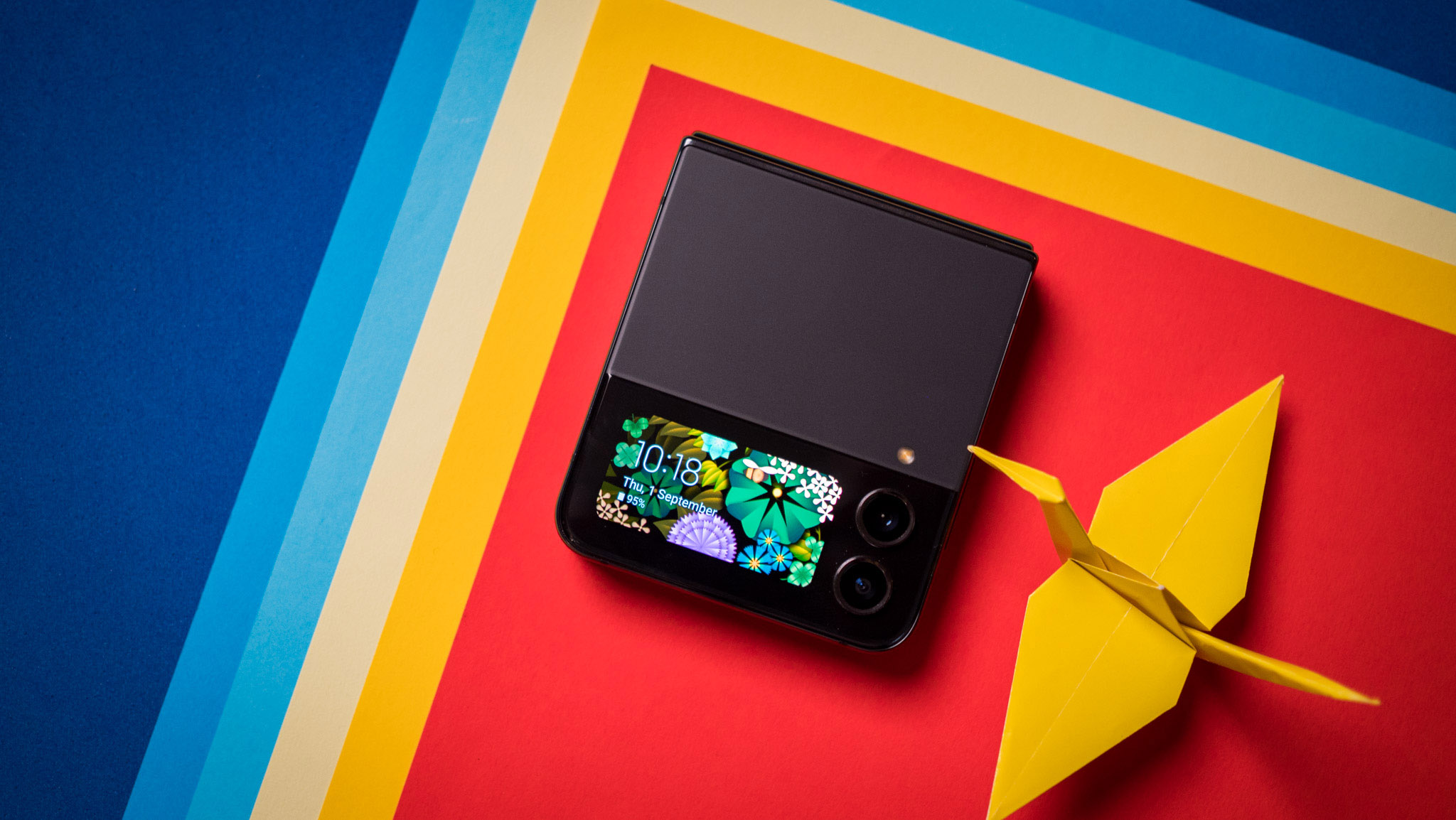
As for the cover screen, it offers an easy way to view notifications without having to open the phone, and you get a decent amount of features. There are widgets for the weather, music, calendar, alarms, timers, and plenty of interesting clock styles to select from. And you can use the always-on mode for the cover screen.
The cover screen has a lot to offer in its own right, and it gets a few new features this time.
A new feature this year is the ability to use the cover screen as a viewfinder for the rear camera, giving you the ability to take selfies with the cameras at the back. This is a welcome addition, and one that I like quite a bit. It's triggered by pressing the power button twice when the phone is folded, and you can switch shooting modes and choose between the two lenses. The cover screen itself is locked to 60Hz, but given it is used mostly for notifications and as a viewfinder for the rear camera, it isn't much of a limitation.
There isn't much you can do with the cover screen other than that, but Samsung's Good Lock customization utility adds a few additional features, but if you're interested in this phone, you should install CoverScreen OS. It is a free utility that turbocharges the cover screen, giving you the ability to launch any app, access all the quick settings toggles, and use navigation gestures. It is a fantastic tool for customizing the cover screen.

A big change this year is the way this plastic layer feels; it isn't as prone to smudges as last year, and most of the time, it isn't a hindrance to usability. After a few days, I didn't pay attention to the film at all, and it is a definite improvement from last year. Another area where Samsung tweaked things is the adhesive itself — the plastic layer is fitted better to the inner screen, and it doesn't look like it will come off with daily wear and tear. The film on my Z Fold 3 started to peel off after three months of use, but that isn't likely to be the case here.
The only issue I have with this panel is that it isn't polarized, so whenever I used the Z Flip 4 with sunglasses on, I couldn't make out what was on the screen. Usually, I see these sort of limitations on budget phones, but for whatever reason, Samsung chose to not add this filter to the foldable, and it makes using it that much more annoying with sunglasses.
Other than that quibble, there's a lot to like about the Z Flip 4. The 6.7-inch AMOLED panel is fantastic for daily use, the cover screen is handy for notifications, and the thinner screen protector makes the foldable that much more enjoyable.
Samsung Galaxy Z Flip 4: Performance
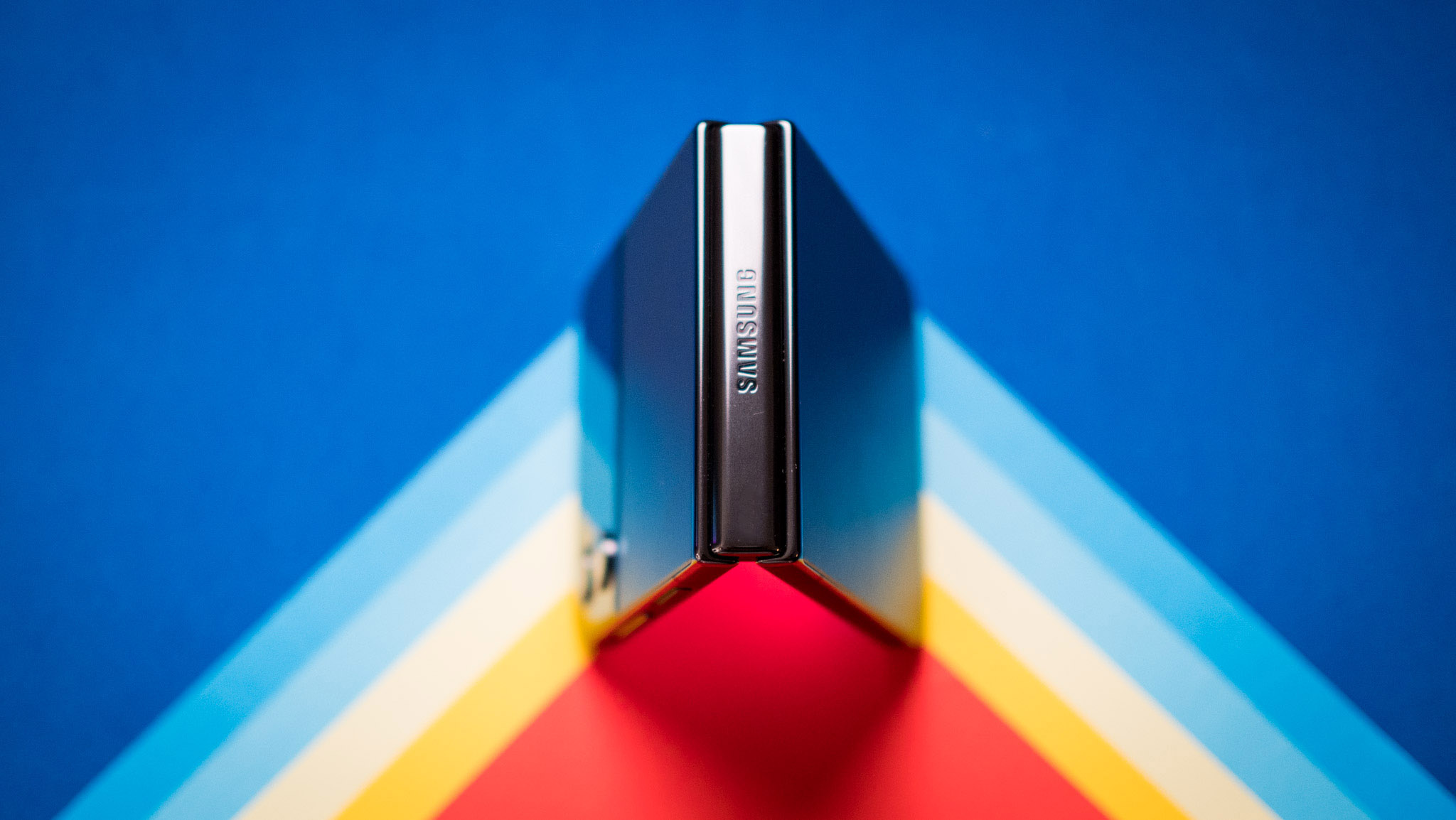
The Z Flip 4 is packing serious hardware in the form of Qualcomm's Snapdragon 8+ Gen 1. This is a mid-cycle refresh with a key difference: Qualcomm didn't make too many alterations to the design itself, but changed the foundry from Samsung LSI to TSMC. That move delivers massive gains in energy efficiency and performance.
I already used several devices with the Snapdragon 8+ Gen 1 — like the Xiaomi 12S Ultra and ASUS Zenfone 9 — and the Z Flip 4 isn't too far behind these rivals. The main difference is that I didn't notice the same effortless fluidity here; that's more likely down to the way Samsung optimized One UI instead of a limitation with the device itself, but using the phone next to the Zenfone 9, it's clear that it doesn't deliver the same level of immediacy.
| Category | Samsung Galaxy Z Flip 4 |
|---|---|
| Operating System | One UI 4.1.1, Android 12 |
| Display | 6.7-inch AMOLED 2X, 2600x1080, 120Hz, HDR10+, 1200 nits |
| Cover Screen | 1.9-inch AMOLED, 512x260, 60Hz, Gorilla Glass Victus+ |
| Chipset | Qualcomm Snapdragon 8+ Gen 1, 1 x 3.19GHz Cortex X2, 3 x 2.75GHz Cortex A710, 4 x 1.80GHz Cortex A510, Adreno 730, 4nm |
| RAM | 8GB LPDDR5 |
| Storage | 128GB/256GB/512GB UFS 3.1 |
| Rear camera 1 | 12MP f/1.8, 1.8um pixels, Dual PDAF, OIS, 4K at 60 fps |
| Rear camera 2 | 12MP f/2.2 wide-angle, 1.12um pixels, 123-defree FoV |
| Front camera | 10MP f/2.4 autofocus, 1.22um pixels, 4K at 30fps |
| Connectivity | Wi-Fi 6, Bluetooth 5.2, NFC, global 5G bands |
| Security | Side-mounted fingerprint |
| Battery | 3700mAh, 25W wired charging, 15W Qi wireless charging, 4.5W reverse wireless charging |
| Audio | USB-C, stereo sound, Samsung Scalable hi-res codec |
| Dimensions (unfolded) | 165.2 x 71.9 x 6.9mm |
| Dimensions (folded) | 84.9 x 71.9 x 15.9-17.1mm |
| Weight | 187g |
| Colors | Bora Purple, Pink Gold, Blue, Black, Yellow, White |
That said, you'll only notice the difference if you use the Z Flip 4 alongside another Snapdragon 8+ Gen 1 device. And for what it's worth, this isn't an issue with the Z Flip 4 but all Samsung phones; the manufacturer needs to do a better job tuning its phones to take full advantage of the hardware. I'm not saying that Samsung's phones are slow; just that they're not as fluid as their immediate rivals.
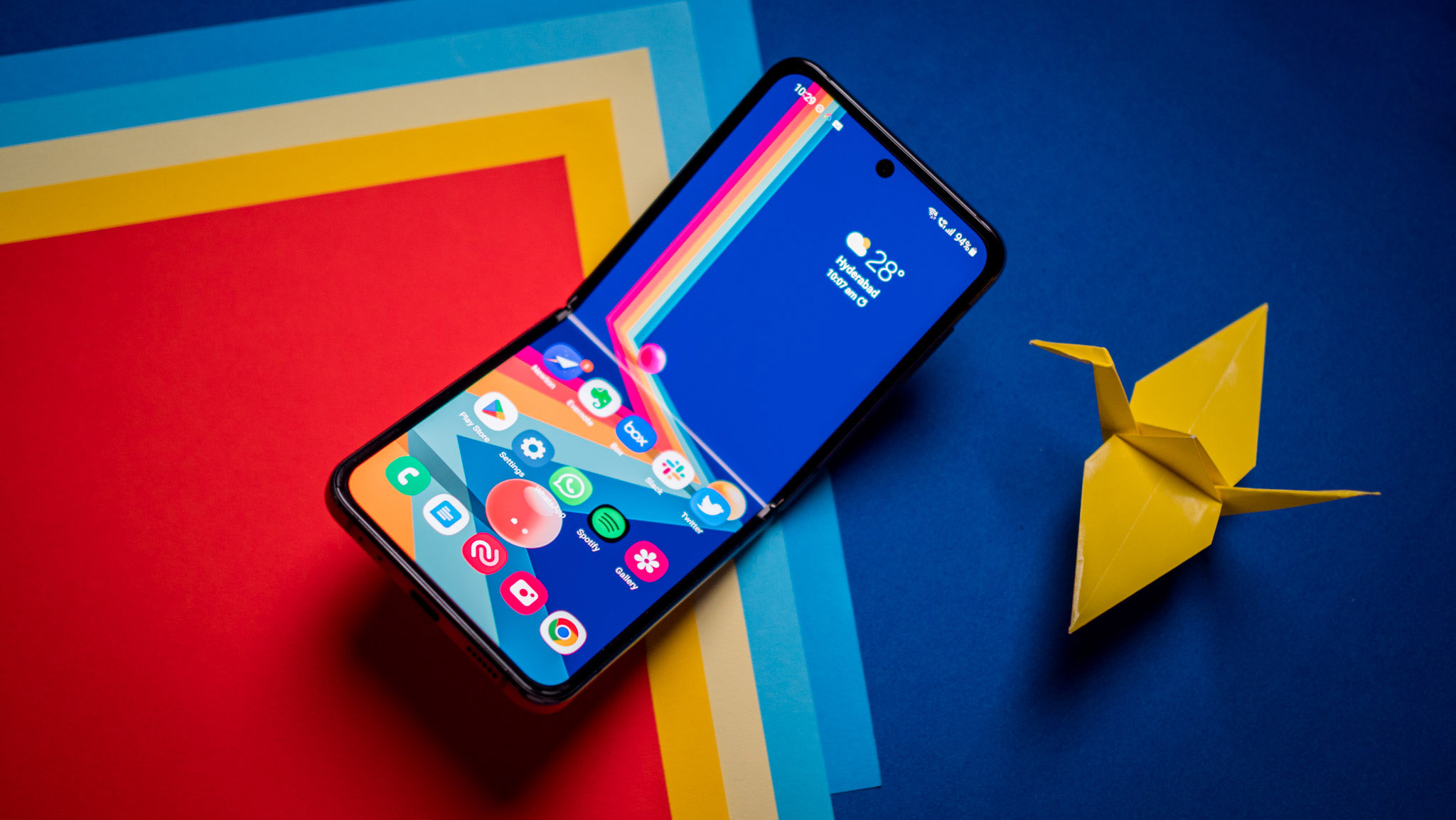
On that note, I didn't see any slowdowns or lag with the Z Flip 4, and it held its own for gaming as well. Because of the unique nature of its chassis — where it folds in half — it is more constricted thermally, and as such the Snapdragon 8+ Gen 1 throttles a little earlier than other devices with the same chipset. This is only the case with extended gaming sessions over 45 minutes, and for every other day-to-day scenario, the Z Flip 4 is just as powerful as the best Android phones.
Elsewhere, you get 8GB of RAM as standard, and the base model of the Z Flip 4 has 128GB of storage, with options going up to 512GB. I feel like this is a shortsighted move from Samsung, given that most Chinese brands now offer 256GB as standard in this category. We're at a point where 128GB of storage is no longer enough — particularly for $1,000 flagships.
As for connectivity, the Z Flip 4 has Wi-Fi 6, Bluetooth 5.2, NFC, Samsung Pay, and Samsung's high-res audio codec, and you'll find global 5G bands. Again, I get the sense that the phone should have come with Wi-Fi 6e, but it's clear that Samsung didn't want to change too many things from last year. On that subject, the vibration motor continues to be excellent, delivering great feedback when using the keyboard and navigation gestures, and other daily interactions.
Samsung Galaxy Z Flip 4: Battery life
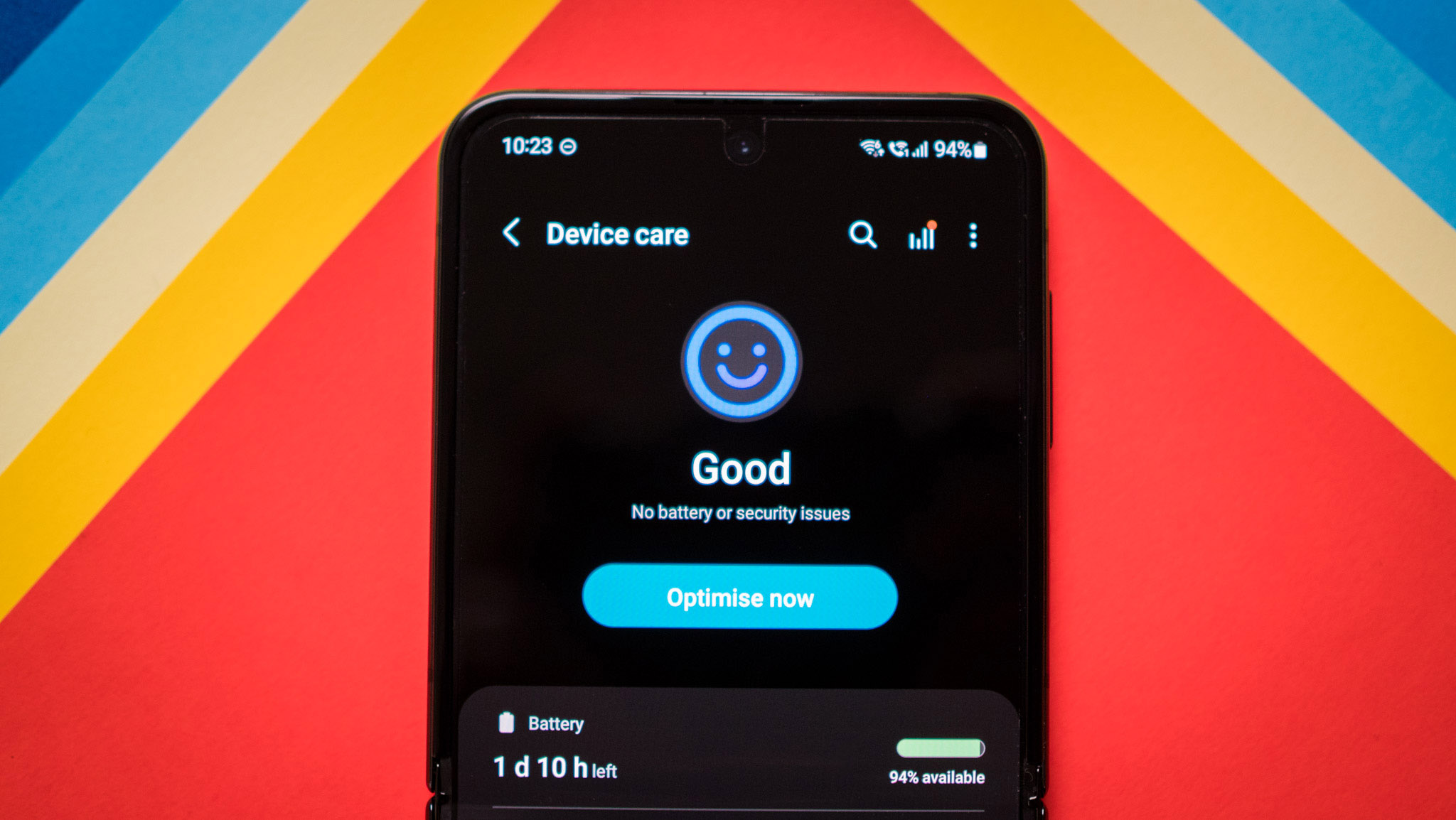
Samsung made necessary changes to the battery side of things with this generation. First up, the foldable has a 3700mAh battery that's 12% larger than last year, and that makes a huge difference in and of itself. Add in the inherent efficiencies of the 4nm node, and the Z Flip 4 lasts noticeably longer.
The Z Flip 4 comfortably lasts all day — there's no battery anxiety here — and you get faster wired and wireless charging.
Samsung also added 25W wired charging (up from 15W) and 15W wireless charging this time around along with 4.5W reverse wireless charging, so you're not being shortchanged in this area. That said, you don't get a charger in the box — although it shouldn't be too difficult to get your hands on Samsung's 25W charger or any USB PD charger.
It takes just under 80 minutes to fully charge the device, and a 30-minute charge gets you a 52% charge. While this isn't anywhere close to what you get with the 80W and 150W standards that Chinese manufacturers offer, it is much better than last year.
As for battery life, I routinely got well over a day's worth of use here, and even on days when I was out all day and relied on cellular data and navigation, the phone didn't go under 15%. I averaged five hours of screen time in daily use, and I never felt the need to plug in the phone before the end of the day. In short, there's no battery anxiety whatsoever.
Samsung Galaxy Z Flip 4: Cameras
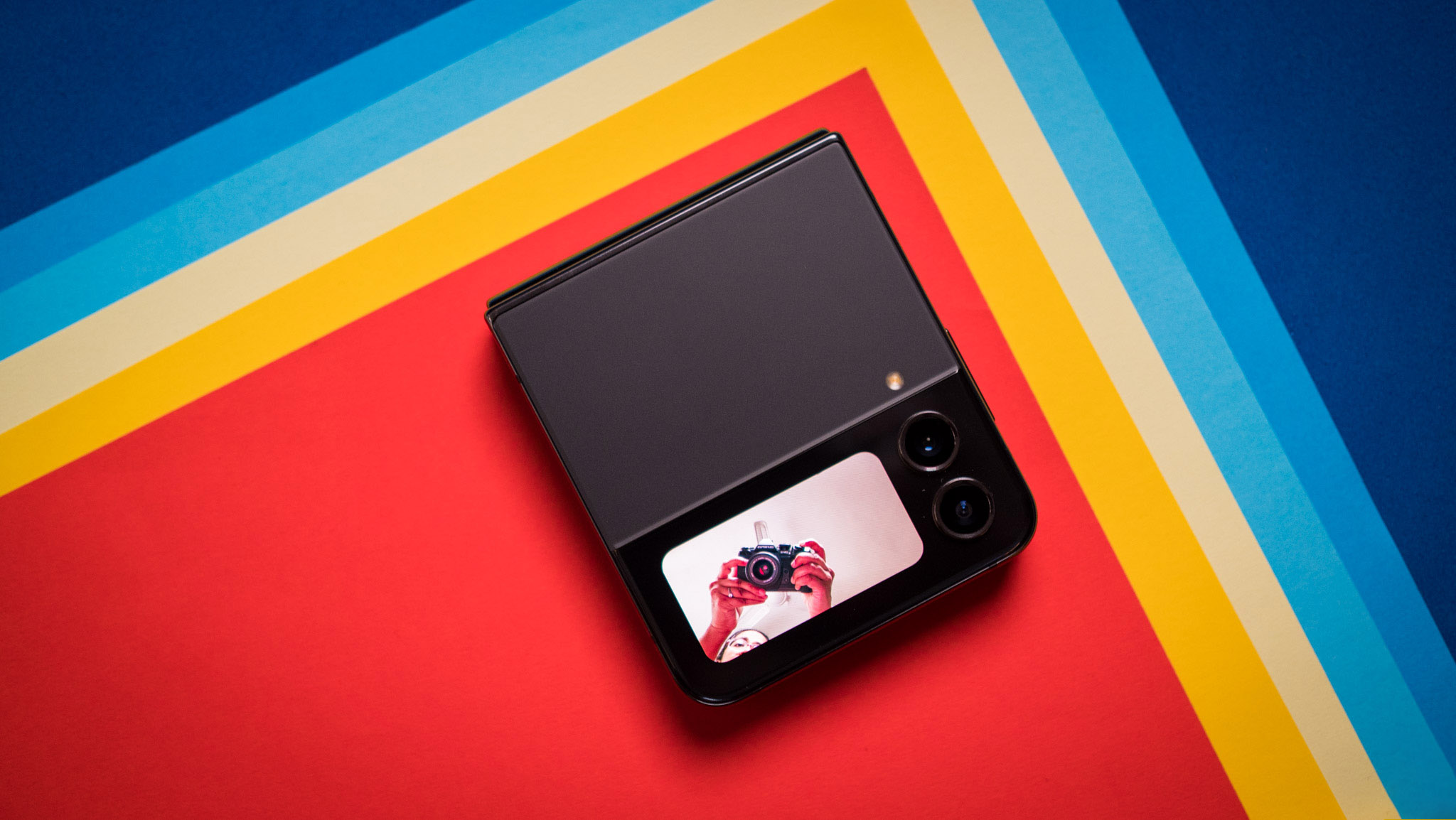
Samsung isn't changing the camera configuration with this generation; the Z Flip 4 has a 12MP lens joined by a 12MP wide-angle module at the back, and there's a 10MP selfie camera tucked in the inner screen. You miss out on the versatility of the zoom lens, but other than that, the Z Flip 4 has a strong overall package.
The new 12MP camera sensor takes phenomenal photos, and you can use the cover screen as a viewfinder for the rear cameras.
For one thing, Samsung is using a new 12MP f/1.8 sensor with larger 1.8um pixels for the primary lens, and it makes a huge difference — this is essentially the same sensor that was in the Galaxy S21 series last year. We've already covered just how good the Z Flip 4 is against the Flip 3, and that's down to the new hardware and improved tuning by Samsung. Of course, the new Qualcomm hardware also comes in handy.
There isn't anything that's different on the UI side of things, with the camera interface identical to other Samsung phones. You get all the shooting modes in a ribbon, plenty of toggles, and a manual mode that gives you better control over your photos. There's the ability to shoot in RAW, and a new feature that I like a lot is the ability to use the cover screen as the viewfinder for the rear cameras.
Of course, being a foldable, you get a few niceties like Flex Mode; the unique nature of the hinge lets you take photos at interesting angles, with the bottom portion of the screen housing all the controls and the top half serving as the viewfinder.
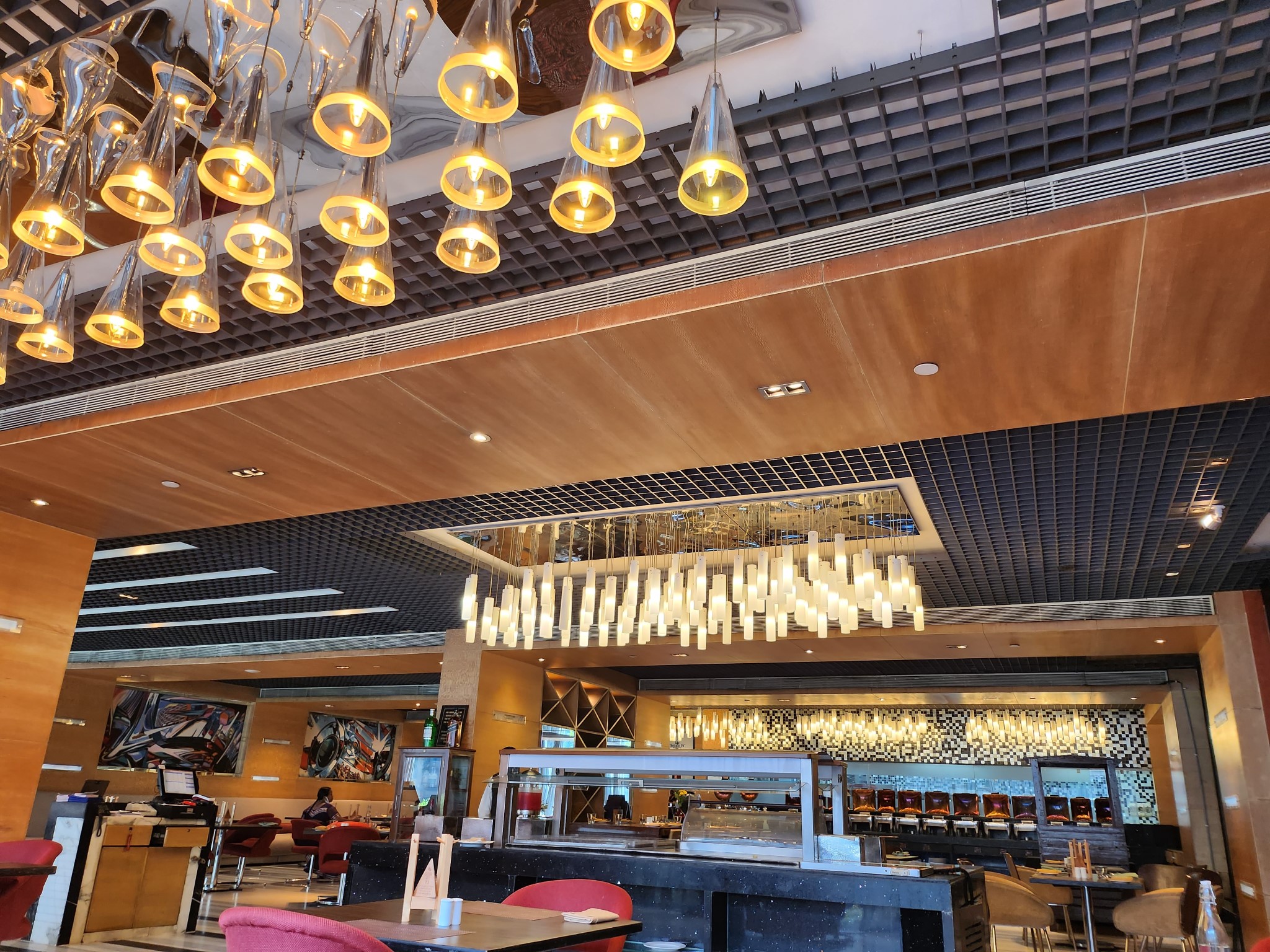

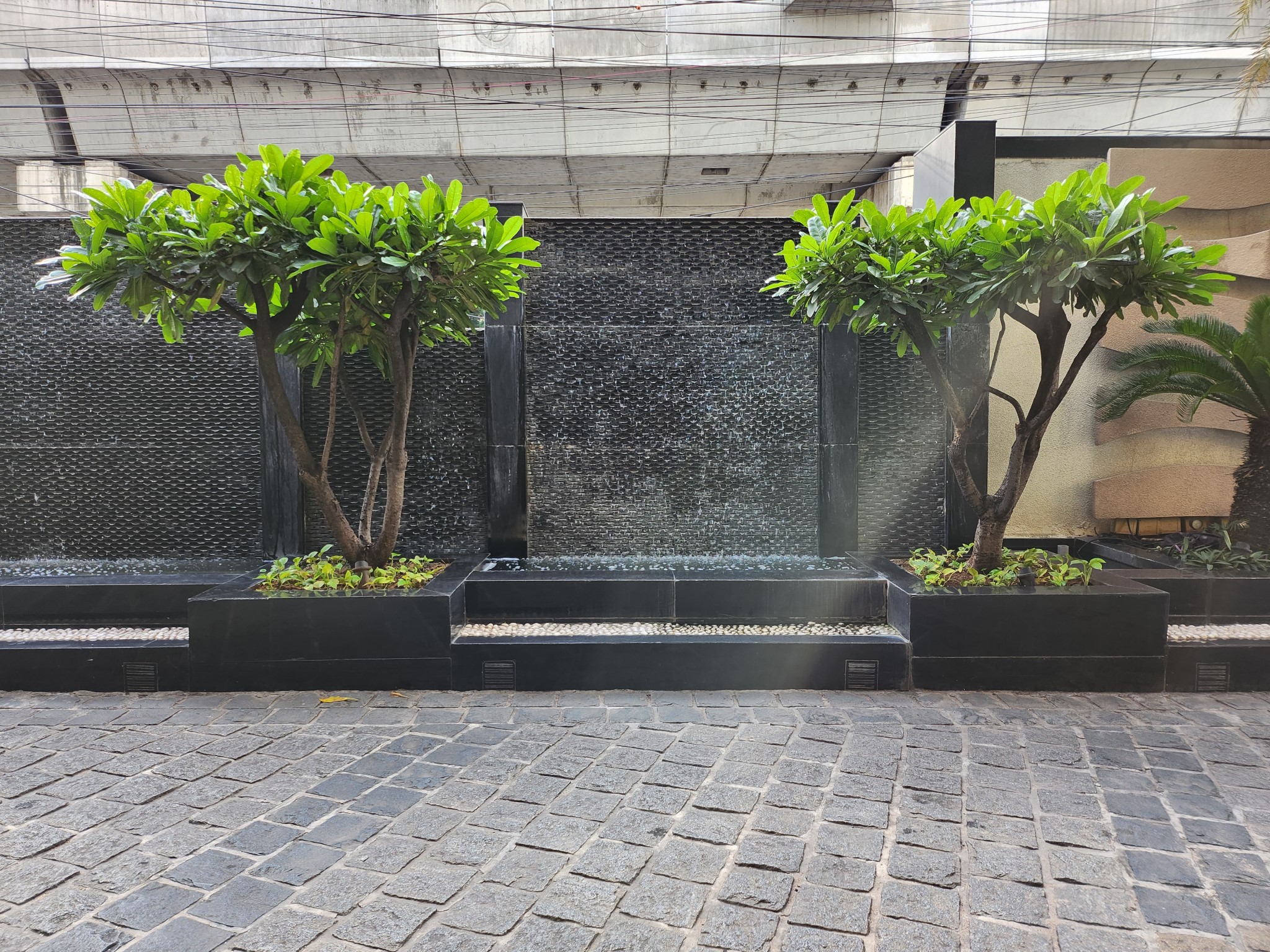


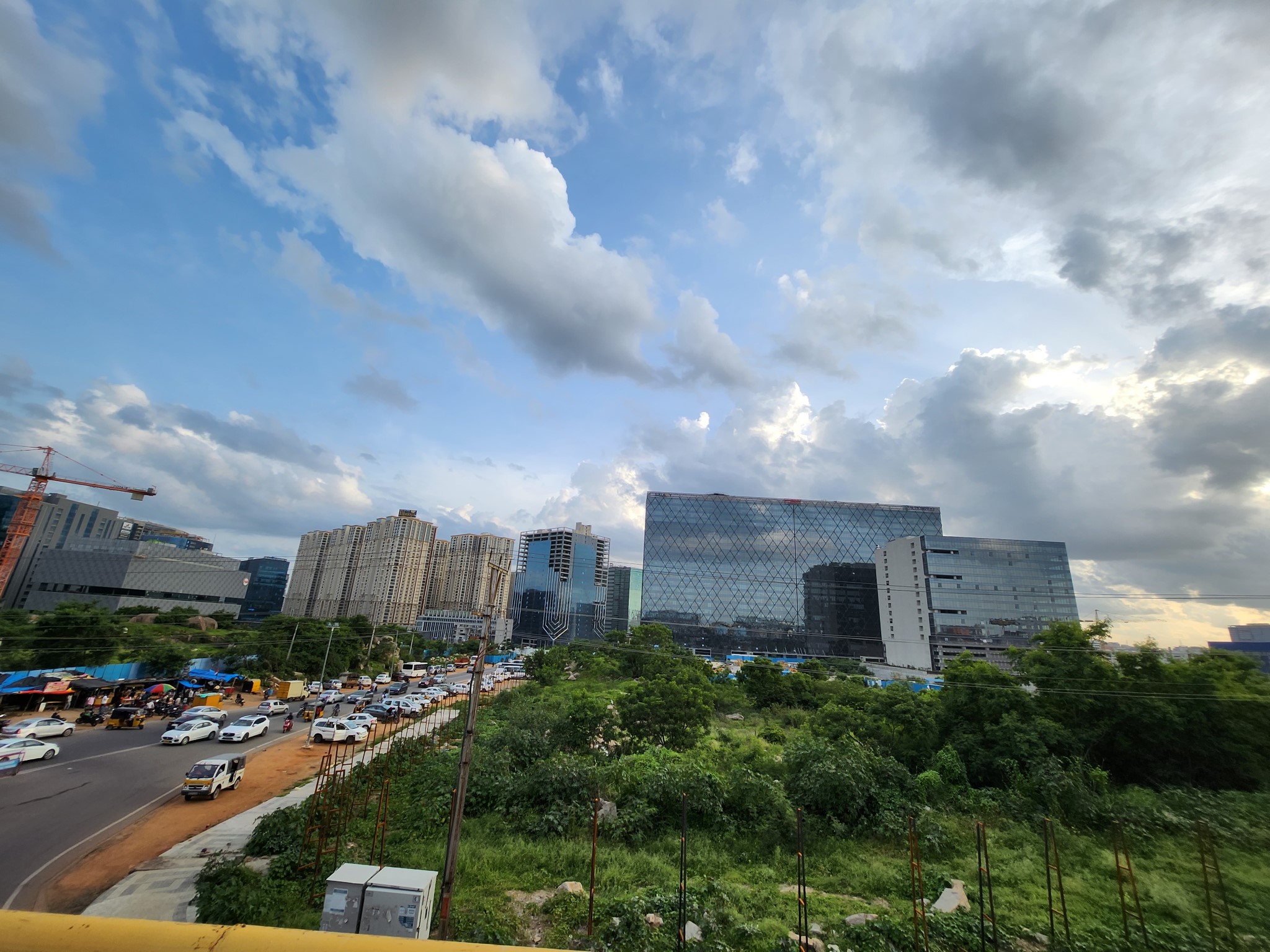

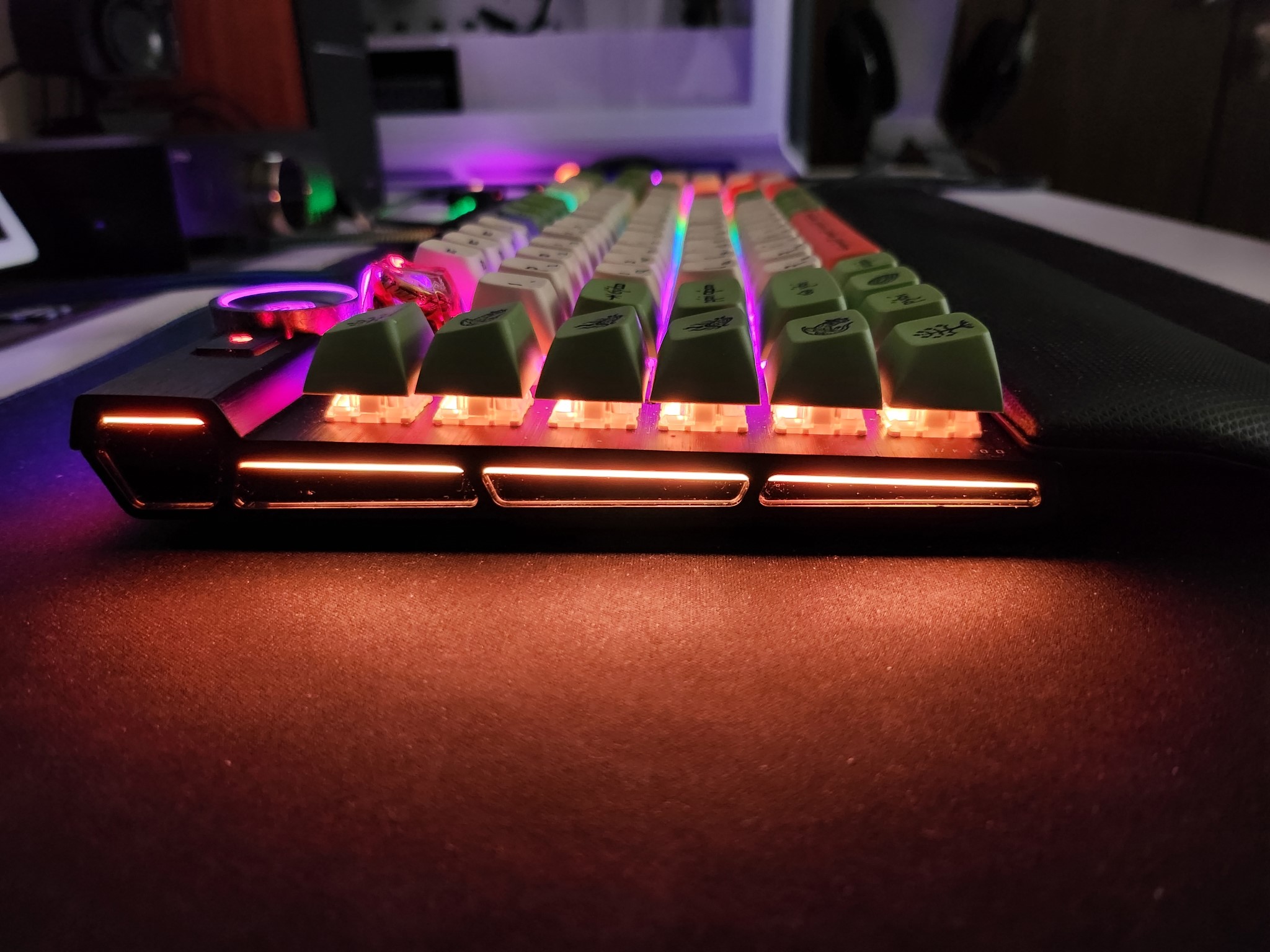

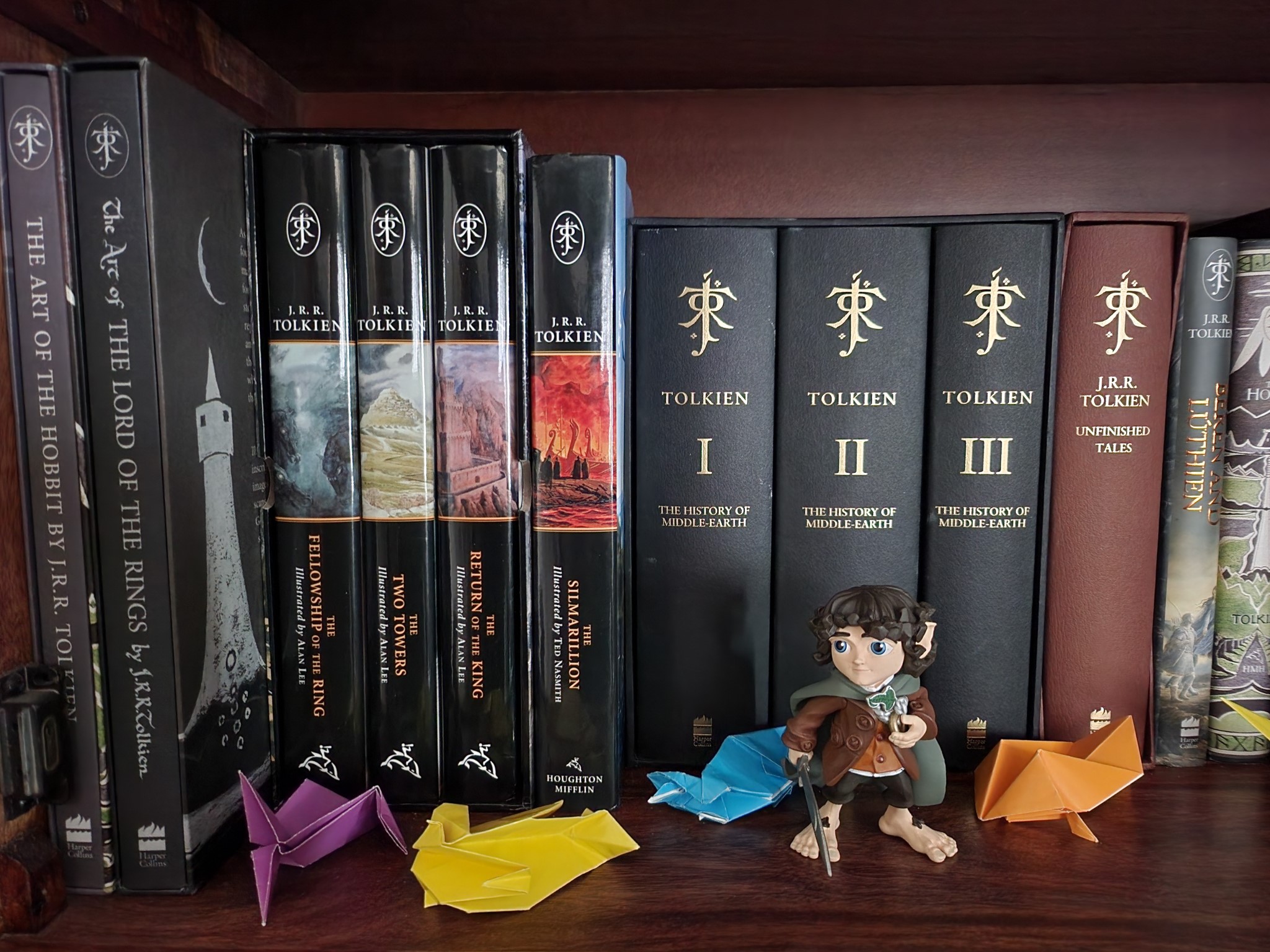
The Z Flip 4 takes outstanding photos in daylight, with the 12MP camera delivering excellent dynamic range and saturated colors that are a mainstay of all Samsung phones. Foliage in particular is very well-defined and you can make out individual shades, and the phone isn't aggressive when it comes to smoothing out artifacts.
In a similar vein, the wide-angle lens fares incredibly well, and Samsung did a good job with portrait mode with this generation — you get better segmentation and background blur. It isn't as good as the Pixel 6 Pro for shooting inanimate objects, but there's a marked difference in this area versus previous years.
The 10MP camera housed inside is decent enough in its own right, but I didn't use it all that much, instead turning to the rear cameras and using the cover screen as a viewfinder. You can switch between the regular lens or use the wide-angle sensor for taking photos with the cover screen, and it is one of the best additions here.
The Z Flip 4 holds up to its rivals for low-light shots, delivering photos with little to no noise levels and plenty of detail. The phone manages highlights well, and color balance is on point — there is a huge difference over last year. The wide-angle lens doesn't quite produce photos of the same caliber, but it is decent enough in its own right, and it should be adequate for sharing on social media.
Samsung got a lot right with the Z Flip 4. The switch to a larger sensor delivers better photos in just about any situation, and the only feature missing is a telephoto lens. Other than that, the phone holds its own against its Galaxy S22 siblings.
Samsung Galaxy Z Flip 4: Software

The Z Flip 4 runs Android 12 based on One UI 4.1.1 out of the box, and visually, it is identical to the One UI 4.1 build. The software should feel immediately familiar if you've used a Samsung phone in the last two years, and it comes with all the features Google introduced in Android 12.
Samsung did all the right things on the software side — the Z Flip 4 is full of meaningful additions.
You'll also find Samsung's own take on the Material You color picker, with One UI offering four color palettes that feature colors from the phone background. Samsung continues to be the only manufacturer other than ASUS to use its own phone dialer, but you get the Google dialer as well if you prefer the latter.
Flex Mode is a useful feature that kicks in when the screen is partially unfolded; it splits the screen in half, with the app taking up the top portion, and the bottom portion turning into a trackpad, giving you better control. I didn't use the mode that much, but it is a good option to have if you use Flex Mode a lot. There's no DeX here, but Samsung's Link to Windows is intact, and there's a continuity feature that lets you use the current app on another Samsung device.
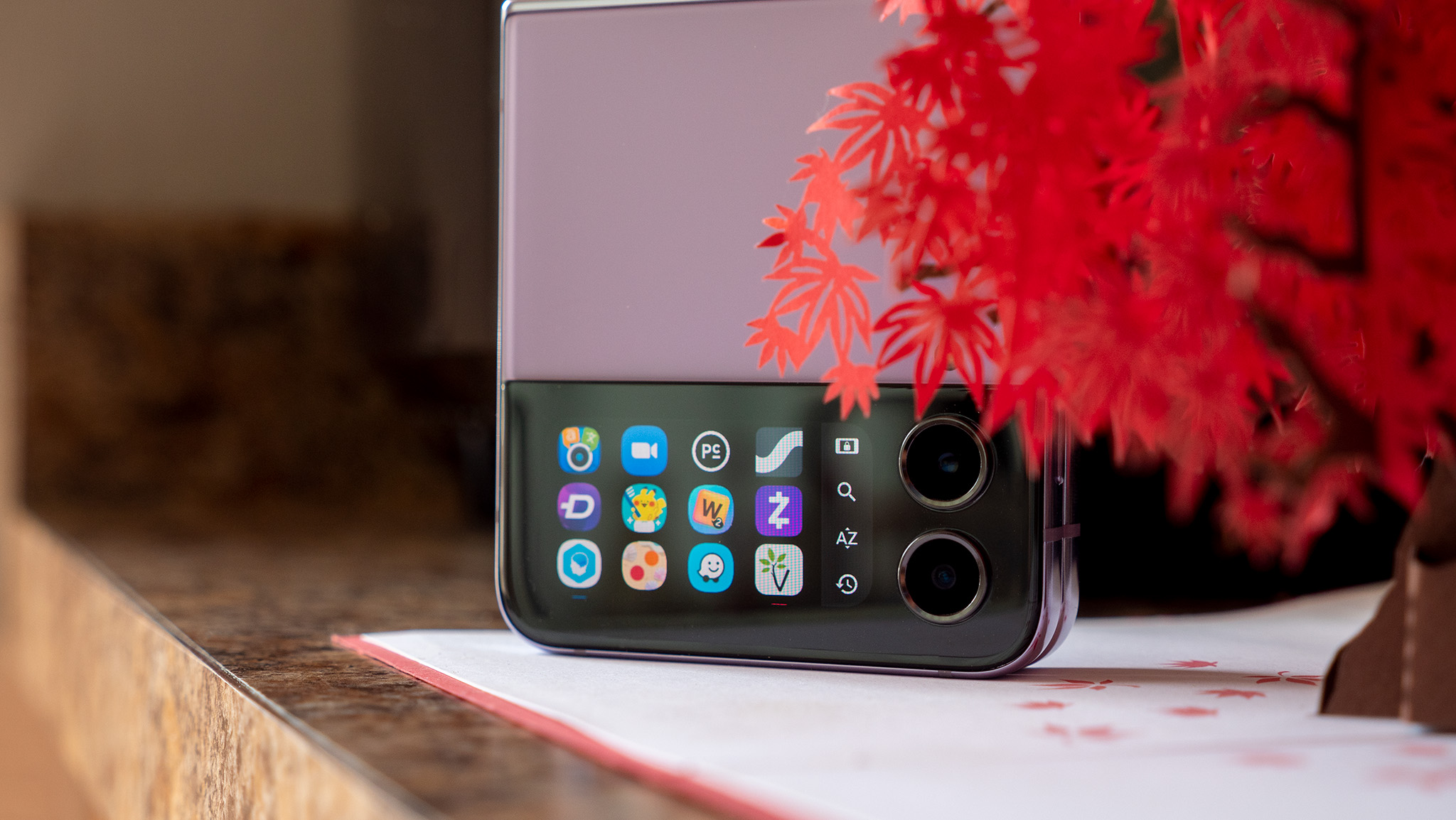
The notification pane has six toggles with the first pull-down gesture, and you'll find the usual device control and media player settings along with a brightness slider. Samsung Pay is intact as well, but like the S22 series, it doesn't have MST, and it relies on NFC. The app drawer is unchanged as well, and so is the bloatware situation — you'll find a lot of pre-installed apps, but on the bright side, you can uninstall most of these.
I usually run into ads on Samsung's flagships (often advertising the phone I'm using), but that wasn't the case here. Samsung said it would make a conscious effort to cut down on push notification ads, and I didn't see any errant Galaxy Store notifications or other ads when using the device.
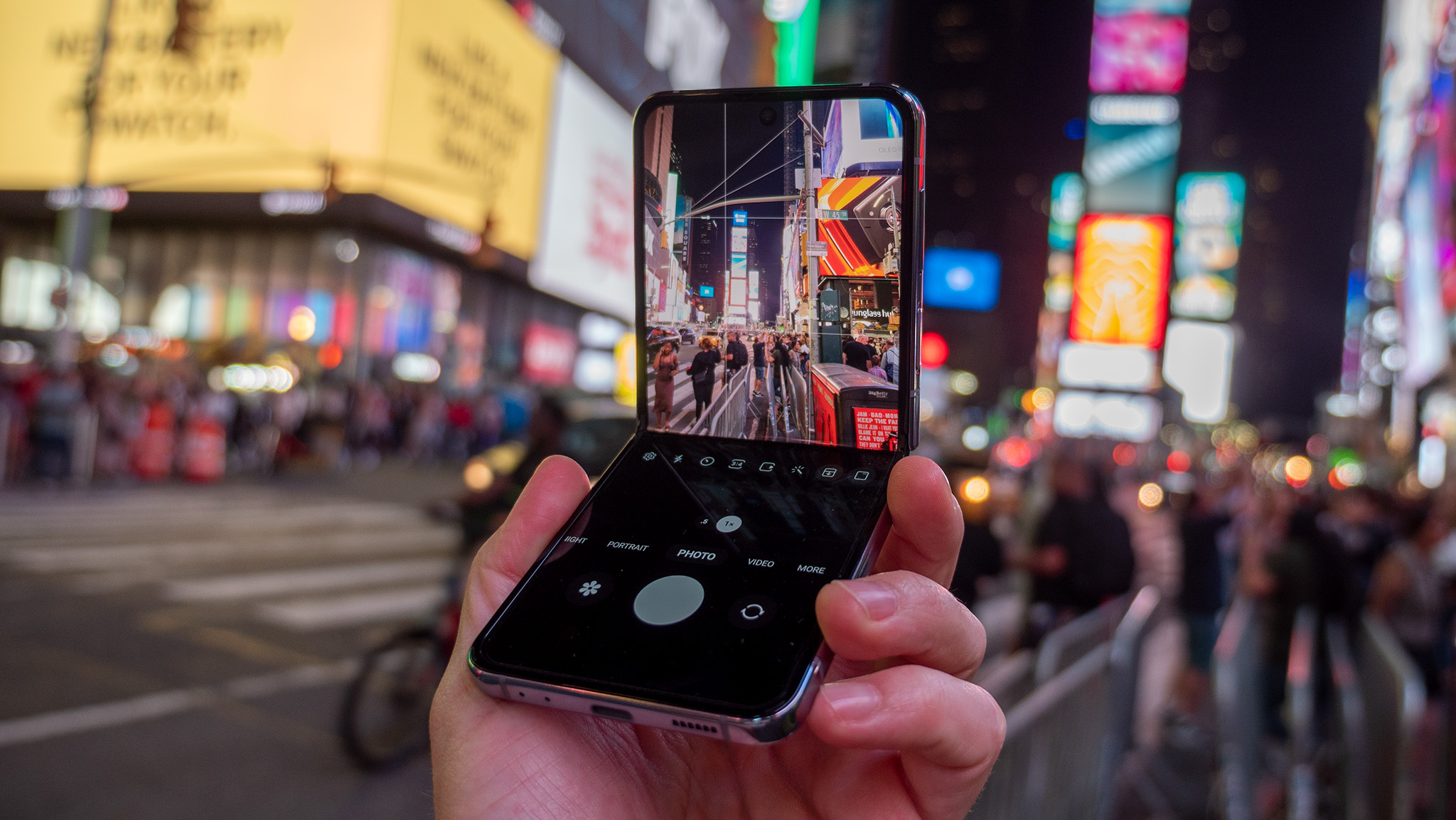
Because there isn't a foldout screen like the Z Fold 4, you don't get a taskbar or some of the other Android 12L features that Samsung baked into the interface, but that doesn't mean the Z Flip 4 is missing out in this regard. I didn't run into any bugs whatsoever in the two weeks I used the foldable, and it was just as reliable as the S22 series.
Samsung is the Android manufacturer to beat for software updates, and it is doing all the right things in this area. You'll get four guaranteed Android OS updates and five years of security updates with the Z Flip 4, and that is more than any other Android device. Samsung is also doing a better job rolling out updates on time; the One UI 5 beta is now live for the Galaxy S22 series, and it should make its way to the Z Flip 4 as soon as the stable build is ready.
Samsung Galaxy Z Flip 4: The competition

If you want to save some cash, the Galaxy Z Flip 3 continues to be a solid alternative to consider in 2022. For one thing, it is a little more affordable than the Z Flip 4, and you get the same screen, a hinge that's just as durable, same level of water resistance, and the internal hardware has a lot to offer. You miss out on a larger battery, faster charging, and better cameras, but the upside is that you'll save around $400. If you're looking for the best foldable value, you should get your hands on the Z Flip 3.
And if you're looking for a small phone that has the latest hardware, you should turn to the Zenfone 9. ASUS did a magnificent job with the device, and it has an interesting design with exciting color options, incredible hardware, great cameras, multi-day battery life, and a sublime 120Hz AMOLED screen. Best of all, it has clean software that's a delight to use, and it is a good value at $699. The downside is that it will only get half as many Android OS updates as Samsung's phones.
Don't want to switch to a foldable just yet? The Galaxy S22+ gives you the same features as the Z Flip 4 without all the folding bits, and because it's been out for a while, you'll find exciting deals for the device.
Samsung Galaxy Z Flip 4: Should you buy it?

You should buy this if:
- You need a pocketable foldable that's water-resistant
- You want the latest internal hardware
- You're looking for a vibrant 120Hz screen and long-term durability
- You want excellent cameras
- You need reliable wired and wireless charging tech
- You're looking for long-term software updates
You shouldn't buy this if:
- You need a creaseless foldable
- You want a foldable for gaming
Samsung didn't reinvent the wheel with its latest foldable. The Z Flip 4 is a little thinner than the Z Flip 3, has a slightly bigger battery, charges faster, and takes better photos. While the underlying fundamentals haven't changed too much, the Z Flip 4 delivers useful upgrades in the areas that actually matter in day-to-day use, and that in itself makes the foldable stand out that much more.
More than anything else, the Z Flip 4 rekindles the joy of using a flip phone.
These tiny upgrades make a huge difference in daily use, and I can confidently say that the Z Flip 4 is one of the best phones I've used this year. The design is refined, the chassis is just as durable as a regular phone, the plastic layer over the screen is barely noticeable, and the IPX8 water resistance is the icing on the cake.
The battery lasts all day and there's no anxiety whatsoever in this area, the cameras take fantastic photos on par with the rest of the Galaxy S22 series, and you get the same wired and wireless charging tech as the S22+.
In short, the Z Flip 4 does everything a regular phone can, and when you're done using the phone, you can just fold it in half. The novelty of that doesn't wear away, and the foldable design combined with the robust feature-set makes the Z Flip 4 one of the best Android phones you can buy today. If you're tired of phones looking too similar and not standing out enough, you need to pick up the Z Flip 4 right now.
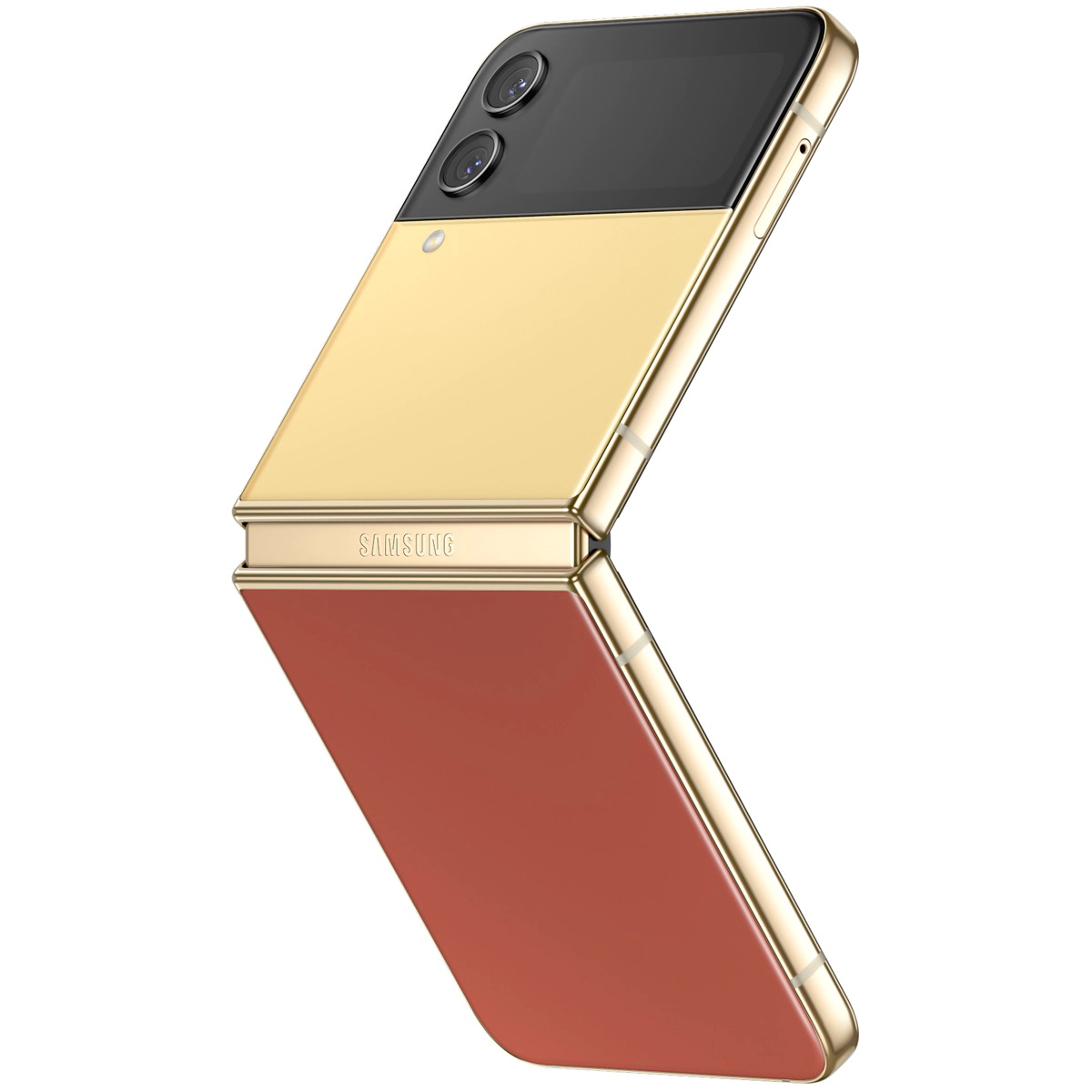
If you're already using the Z Flip 3, it doesn't make that much sense to upgrade to the Z Flip 4. The phone has useful upgrades in a lot of areas, but the fundamentals are unchanged. But if you're using a regular phone and want something that stands out a bit more, the Z Flip 4 is the obvious choice. The flip action is delightful in daily use, the 120Hz AMOLED panel is awesome, and it takes outstanding photos.

Harish Jonnalagadda is Android Central's Senior Editor overseeing mobile coverage. In his current role, he leads the site's coverage of Chinese phone brands, networking products, and AV gear. He has been testing phones for over a decade, and has extensive experience in mobile hardware and the global semiconductor industry. Contact him on Twitter at @chunkynerd.
